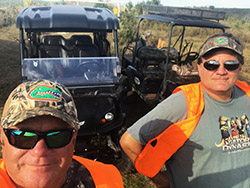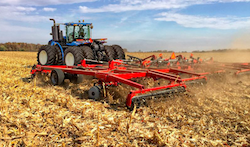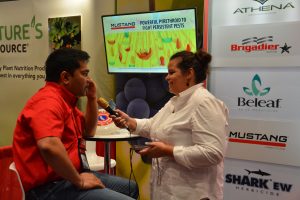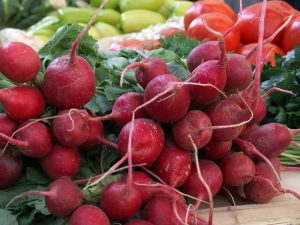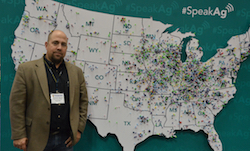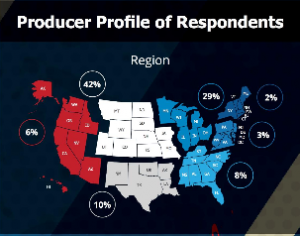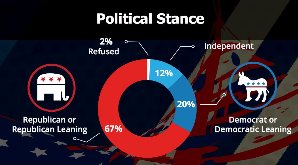Powdery mildew has been a stand-out problem in California according to Matt Rackerby, strategic business specialist for FMC. In fact, one grower told him that in 50 years of growing grapes, it’s the worst powdery mildew he’s ever seen. This season proved to be the perfect conditions for the disease to grow and people who didn’t address it early and often, struggled. So what is a good solution? I learned the answer from Rackerby during the 2016 CAPCA Conference & Agri-Expo that took place in Anaheim, California.
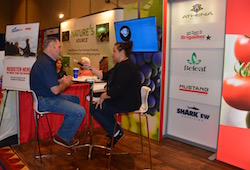
FMC’s Matt Rackerby discussing Rhyme and Fracture fungicides during the 2016 CAPCA Conference.
FMC has a new product to specifically address this disease, Rhyme fungicide, and Rackerby said under heavy pressure, things looked good for growers who used the product. Rhyme is a FRAC 3 fungicide. It’s not a new class, but rather a new chemistry. “So what makes it a standout product in that class is that translocates very, very well. So well in fact, we’re expecting a label soon that allows chemigation. If you put it through a drip system the plant will suck it up,” Rackerby explained.
There is also a special label in Texas where Rhyme is helping to control a root rot that they don’t have in California. It’s controlling the root rot and it’s being taken up by the vines providing powdery mildew control as well.
“If you haven’t used a FRAC 3 fungicide for awhile because you think you wore it out, it’s time to come back to it now, but come back to the best one on the market and Rhyme fungicide is a good performer, said Rackerby. He added that its performance makes it a great tool for use in resistance management strategies. Besides rotating and tank mixing, he said other options are to find totally new fungicide classes to integrate into their programs such as Fracture fungicide, a new mode of action fungicide that helps control mid-season disease issues such as powdery mildew and botrytis.
I asked him what are the challenges going into the 2017 crop. He said that the biggest challenge is water. The growers have been getting less and less water each year, said Rackerby so they are having to learn new ways to conserve resources, but more water allocation for the state’s ag industry is needed.
To learn more, listen to my interview with Matt Rackerby here: Interview with Matt Rackerby, FMC on Rhyme and Fracture
I couldn’t resist asking Rackerby about an oldie but goodie FMC product, Shark® EW, herbicide. Rackerby said that while most PCA’s and growers know about the product, FMC is continually add to the label by adding crops and making the label more useful. Speaking of new uses, Rackerby said growers can now use Shark EW on alfalfa when they burn down during the dormant period. They can either add it to other products or they can use it alone. In the summer a grower can use it in between cuttings.
Learn more about Shark here: FMC's Matt Rackerby on Shark EW
Be sure to check out even more action by viewing the 42nd Annual CAPCA Photo Album.
Legal: Always read and follow label directions. Shark EW herbicide is only registered for use in California. FMC Fracture, Koverall, Rhyme, Shark and Sovran are trademarks and Investing in farming’s future is a service mark of FMC Corporation or an affiliate. ©2016 FMC Corporation. All rights reserved. 16-FMC-0857, 10/16
 “The crop is bigger than we’ve seen before, we just keep being able to produce these records,” said Wesley Spurlock, a corn farmer from Texas who just took over as NCGA president at the beginning of October. “Demand is what we’re working on. It’s demand, demand and more demand.”
“The crop is bigger than we’ve seen before, we just keep being able to produce these records,” said Wesley Spurlock, a corn farmer from Texas who just took over as NCGA president at the beginning of October. “Demand is what we’re working on. It’s demand, demand and more demand.”


